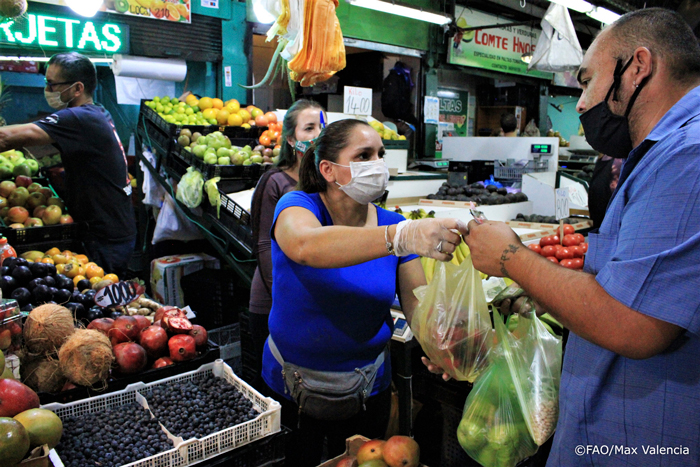How are local governments responding to the COVID-19 pandemic?
 Lo Valledor, the main wholesale market in Chile, continues to provide the public during this health emergency with all the protective measures for them collaborators and the community.
Lo Valledor, the main wholesale market in Chile, continues to provide the public during this health emergency with all the protective measures for them collaborators and the community.James Tefft, FAO Investment Centre Senior Economist, talks about the leadership of governors, mayors and other local officials in keeping food systems functioning during the COVID-19 pandemic.
What are the biggest challenges to food systems?
The nature of the pandemic is giving rise to new challenges to food system actors at every level. We’re seeing disruptions to food supply chains and logistics, rapid changes in consumer food behaviour, more worker safety measures required. There’s a need for stronger public, private and community safety nets to feed the growing number of people who have lost jobs or income. In many low-income countries, poor households spend up to 70 percent of their income on food.
How are local officials responding?
Local officials have a critical role to play in adapting and supporting food systems to conform to COVID-19 health directives while also ensuring the local population’s food security.
Governors, mayors and local authorities are close to the populations they serve. They understand their needs. After schools closed in the Republic of Korea, along with the innovative Eco-Friendly Free School Meal Program, numerous governors and mayors took to social media. They worked with agrifood promotion agencies and collaborated with producer and food company associations to adapt marketing plans or facilitate the direct sale of surplus supplies of potatoes, fresh fruit, vegetables and fish.
In Italy, local government worked with farmers and food businesses to address housing and health issues of the migrant workers needed to harvest fruits and vegetables. In North America and Europe, local government officials have helped food banks, community kitchens and community-supported agriculture respond to the huge demand for their food.
Local private sector food industry groups, producer and informal food sector associations, civil society organizations and citizen groups are playing equally prominent roles to ensure supply chains function. They are making sure workers are protected and vulnerable populations reached. Residents in apartment blocks in China and Italy, for example, use group chat apps for joint food purchases and spaced delivery to household doorsteps.
What about food markets?
Functioning food markets are essential to meet the food needs of local populations, providing jobs and fiscal revenues. Local governments in China’s Hubei Province worked with wholesale food market officials on measures to ensure the safety of workers, transporters, market operations and local food supplies.
In India, traditional local government assemblies and food market and health officials worked with state agriculture officials to develop containment compliant measures to keep agriculture and food markets working. They marked trading floors to maintain spacing, set trading times, issued e-passes to market traders, workers and transporters, controlled truck deliveries and vehicle traffic, set up farmer-to-consumer stalls across cities, allowed farmer-to-trader sales outside markets to avoid congestion and mandated compulsory masks, hand sanitization and regular market disinfectant sprays.
What do you see as critical actions for local governments?
We see five key actions that can help local governments address food system issues in this COVID-19 era. Obviously, the context will differ between countries and localities; government actions in a rural area or low-income suburban community will differ from those in a capital city or fast-growing secondary city in Asia and sub-Saharan Africa. Leadership is the common thread that links local government action – from prioritizing, planning and overseeing actions, to liaising with private sector and civil society networks, to communicating clearly and regularly with the public.
One, prioritize food systems as an essential service that will continue to operate during periods of lockdown, emergency or other health containment measures.
Two, establish a local government food system coordination committee and functional governance mechanism to prioritize, plan and oversee operations.
Three, provide leadership to rapidly activate or develop a COVID-19 food system response plan.
Four, generate rapid diagnostic data and information to inform decision-making.
Five, find innovative ways for all essential food system channels to comply with virus containment measures and continue to serve their diverse clients.
Actions taken at local level complement food system leadership provided by national governments and global leaders. Diverse measures contribute to ensuring that global and intra-regional trade in food and agricultural inputs is not disrupted, food supplies are adequate, prices are stable, major bottlenecks are quickly addressed and everyone remains confident in the food system.
How can organizations like FAO help?
Local governments and their private sector and civil society food system counterparts need financial and technical support. We can help build the capacity of key local actors. We can also prioritize investments now to strengthen food system resilience in a post-COVID-19 world. And we must ensure local actors benefit from the experiences, capacities and expertise of various coalitions of local food sector actors, global food city networks (e.g. Milan Urban Food Policy Pact) and development and financial partners.
Read the full article on Food Tank here.
